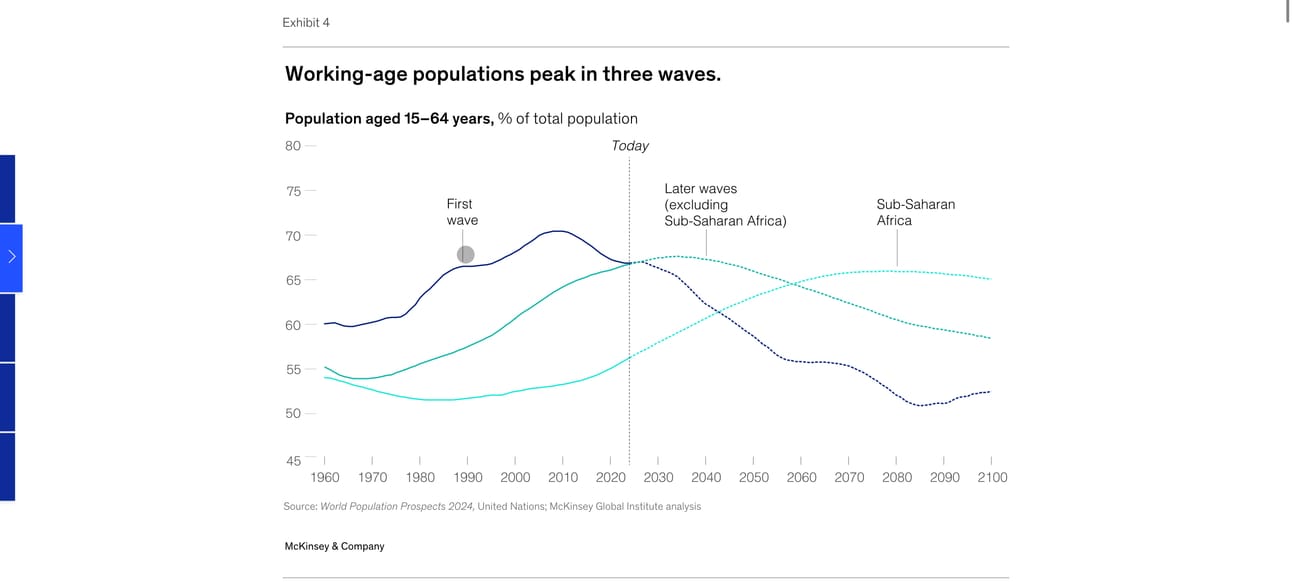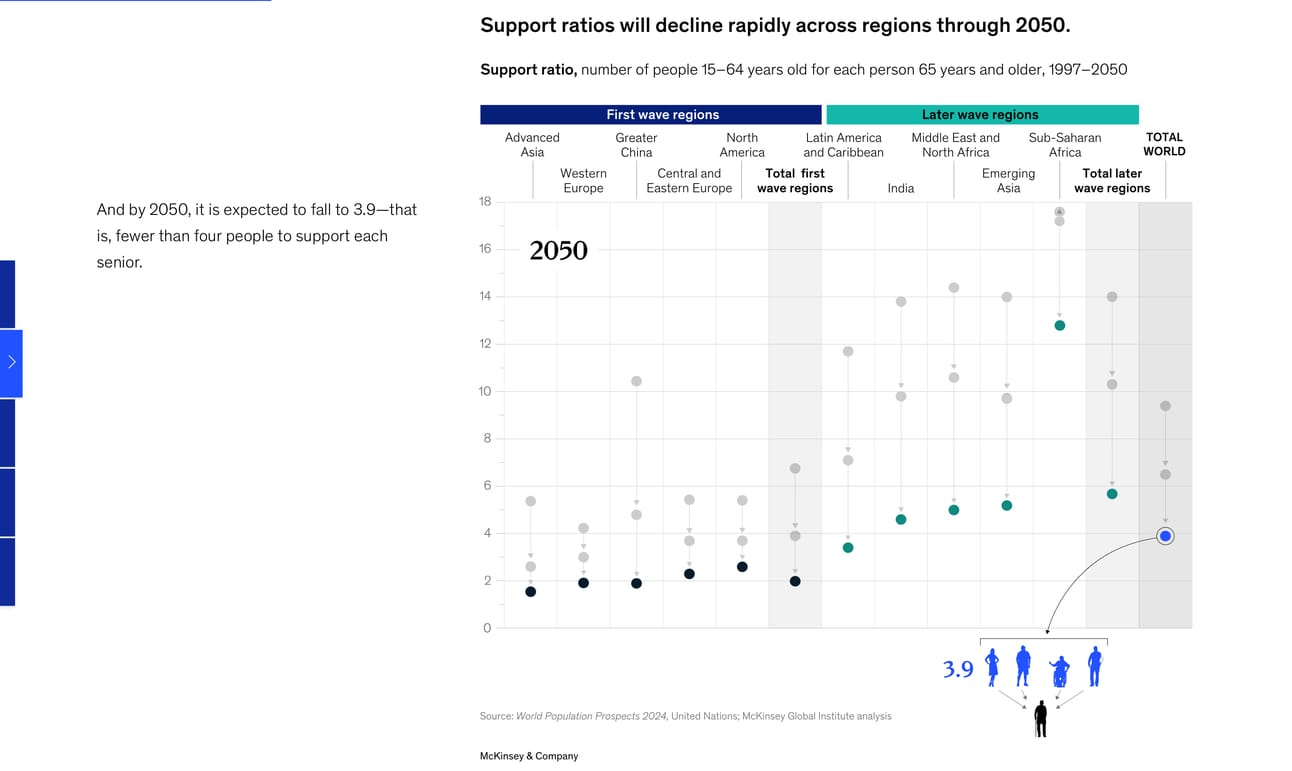- The New Rules with Alan Pentz
- Posts
- Long Cats, Short Babies
Long Cats, Short Babies
The New Rules of Demographics
Welcome back to The New Rules
A quick message before we jump in:
If you’re reading this online, subscribe HERE and join over 8,000 people who want to understand the world better by receiving these emails every week.
And don’t forget about The New Rules podcast where I go deeper on my posts or bring in a guest whose ideas I find intriguing.
Let’s dive in…
One of the biggest long term trends that I’ve yet to write about is demographics. The reality is a lot fewer people are having babies these days and the ones that are are having fewer of them. Pretty soon it feels like we’ll all become another one of JD Vance’s childless cat ladies and then the human race will go extinct.
If you are in markets the trade is to go long cats (who will apparently be in demand to substitute for our children) and short actual babies. That is until all the humans die out and then the cats are going to have to fend for themselves. Please don’t declaw your cat, he’ll need those to scratch out an existence the post-human world.
Of course I’m joking but sometimes it feels like not that much.
Sponsored
Two friends, Pete and Jake, each bought small businesses in 2023 after months of searching.
Pete figured he'd learn on the job. Jake invested in expert coaching.
One year later, Pete was still wrestling with the same problems: unpredictable cash flow, employee turnover, and 70-hour work weeks.
Jake? He'd systematized his operations, doubled his margins, and now takes Fridays off with his kids.
The difference? Jake accelerated his learning curve with proven systems that helped him avoid costly rookie mistakes. He got there in months, not years.
Don't be Pete. Join The Owner Institute’s upcoming mastermind group.
Spots are filling up: Apply Now.
A Shrinking World
McKinsey recently released a good report on the future of world demographics. I pulled out three key charts. First is a comparison of global fertility rates from 2023. The key figure is the average number of children each woman has in her lifetime. A steady population with little growth or decline is 2.1 babies per woman. She has to replace herself, the father, and .1 of another person who gets hit by a car or gets a terrible childhood disease.

It’s not a pretty picture in most parts of the globe. China is at 1.0. That means within a generation or two China will have less than half the number of people it does today. South Korea and Japan are in the same boat. Europe is slightly better at 1.4 and the US better still at 1.6. However, all else equal that means most of the key global powers today are going to shrink.
Areas of the developing world are still growing: the Middle East, Indonesia and Malaysia, and most of all Sub-Saharan Africa. However by 2050 the only region that won’t be in decline is Sub-Saharan Africa. McKinsey shows it as three waves:

Start preparing those Dubai investments now because you’re going to need them by the 2030s. I hope I don’t live long enough to have to invest in Angola. A shrinking population isn’t great. After all, what happens to housing and other asset prices when half the people are around? What happens to growth and how do you support all the old people?

Most pension and old age health care safety nets were crafted when the number of working and tax paying adults to every retired person/beneficiary was far higher than today. When Social Security got started there were thousands of people paying into the system for every recipient. In 1955 it was 8.6, 4.0 in 1965 when we added on Medicare, and now we are at 2.8 and falling.
Most of Western Europe, China, Japan, etc will be below 2.0 by 2050 and the world as whole will go from over 6.0 today to 3.9. That makes these systems unaffordable and the burden placed on workers ever more oppressive. At some point these systems collapse.
An Old Person’s Work is Never Done
There are two approaches to fixing the problem. The first is the main focus on McKinsey’s report. They mostly assume birth rates continue falling so the only way to keep countries solvent is to get old people to work more and to work more efficiently (aka increase productivity).
Both of these have some promise but won’t meet the mark. Older people will certainly have to work longer in the future. French socialists trying to REDUCE the retirement age are some of the most delusional people on the planet.
However, I don’t see an appetite for people to work a lot more hours in addition to more years. My guess is older people work at reduced hours to an older age (That’s what Biden did). After that they’ll probably chose to be poorer over working more. Or course that’s after the politicians they vote for exhaust every kick the can down the road political tactic in the book which will make the long-term problem even worse.
We’ll also get some benefit from increased productivity as AI and other technologies advance. That will help but I think the rate of innovation will also slow as the population ages. Even if AI can invent lots of new things, older people are slower to adopt new innovations. Unless we get some way to reverse aging, I see limited gains to productivity.
Fix Fertility
Of course the other way to solve the problem is by increasing fertility. A lot of research and experimentation has been done on how to increase fertility. So far it’s amounted to not that much. Hungary has famously paid large sums for couples to have children increasing the amounts for every subsequent child. The Nordic countries have implemented incredibly generous parental leave with pay programs.
In some cases birth rates go up but they tend to drift back down after the initial results and none of these policies have gotten a country back to replacement level. I’m sure the cat population is exploding even without subsidies but McKinsey doesn’t have any data on that.
I’ve become even more pessimistic about these policies reading the work of Lyman Stone who is a pro-natalist researcher and advocate. He shows that many of the common reasons we attribute declining fertility aren’t born out in the data. Increasing wealth, dense cities, cost of raising children, lack of parental leave, etc. have been put forward as possible candidates for low fertility. Those factors are correlated but they don’t appear casual.
What does seem to make a difference is the decline in child mortality rates. Women had more babies in the past knowing some would die. They tended to overshoot their preferred number of children. As child mortality dropped, they started undershooting. No one knows why.
Another likely cause of low fertility appears to be less marriage and the weakness in male wages. These feel like very difficult problems to address. We can provide marriage subsidies and try to reconfigure the economy to support more jobs that men tend to prefer and/or excel in like manufacturing. Paying marriage subsidies is going to be tough to get politically. I don’t even see it on the agenda yet.
I’m more optimistic about the later approach as an outcome of reordering our global trade and economic system. Maybe that could make a real difference. I wonder though if we’ll see a bit of an uptick in fertility from a new policy mix but not enough to make a huge difference or get us back to replacement level.
I also think we can continue to support reproductive technology to extend the time in which a woman can carry a pregnancy. That should help a bit too but I’d point out that we’ve been doing that even as the fertility rate plummets so again not a panacea.
What Will Work?
The short answer is I don’t know. I certainly think we have to try some new approaches.
One radical solution is to condition people’s retirement benefits on having children. You don’t breed, you don’t get Social Security. You’ve got to have three kids to get the Medicare drug benefit. Two only gets you the basic coverage. That kind of thing. That would actually work but it’s a pretty dystopian solution and we are a long way away from ever being able to do that politically.
My ultimate best guess is that the retirement systems across the developed world gradually become untenable and benefits are cut or devalued bit by bit. Eventually people will come to see them as inadequate and then maybe they‘ll start having children to support them in old age. That’s what people did in past times. You create your own retirement plan with children. How’s that for privatizing our social safety net?
This is an area I’m going to continue to monitor and research. I admit I’m pretty stumped. Will preferences just change at some point and result in more babies? Possibly. Will we gradually decline so we feel like we’re living in an abandoned city like 600s Rome? Possibly. Could we all be upload consciousness into robots and live forever? Maybe. Your guess is as good as mine.
What do you think?

P.S.
Reply